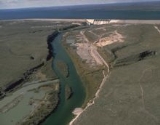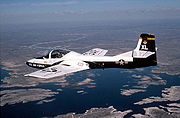
Amistad Reservoir
Encyclopedia

Rio Grande
The Rio Grande is a river that flows from southwestern Colorado in the United States to the Gulf of Mexico. Along the way it forms part of the Mexico – United States border. Its length varies as its course changes...
at its confluence with the Devils River
Devils River (Texas)
The Devils River is a pristine, whitewater river in southwestern Texas, USA. It begins in northwest Sutton County, at , where six watercourses come together, Dry Devils River, Granger Draw, House Draw, Jackson, Flat Rock Draw, and Rough Canyon...
12 miles (19 km) northwest of Del Rio
Del Rio, Texas
Del Rio is a border city in and the county seat of Val Verde County, Texas, United States.. Del Rio is connected with Ciudad Acuña via the Lake Amistad Dam International Crossing and Del Río-Ciudad Acuña International Bridge...
, Texas
Texas
Texas is the second largest U.S. state by both area and population, and the largest state by area in the contiguous United States.The name, based on the Caddo word "Tejas" meaning "friends" or "allies", was applied by the Spanish to the Caddo themselves and to the region of their settlement in...
, USA. The lake is bounded by Val Verde County
Val Verde County, Texas
Val Verde County is a county located on the Edwards Plateau in the U.S. state of Texas. In 2008, estimated population was 55,000. Its county seat is Del Rio. In 1936, Val Verde County received Recorded Texas Historic Landmark number 5625 to commemorate its founding.Val Verde, which means "green...
on the Texas side of the international border, and the state of Coahuila
Coahuila
Coahuila, formally Coahuila de Zaragoza , officially Estado Libre y Soberano de Coahuila de Zaragoza is one of the 31 states which, with the Federal District, comprise the 32 Federal Entities of Mexico...
on the Mexican side of the border. The reservoir was formed in November, 1969 by the construction of Amistad Dam
Amistad Dam
Amistad Dam is a large dam across the Rio Grande on the United States-Mexico border. It serves to store water for irrigation and generate hydroelectricity. The dam was first proposed in a 1944 treaty between the United States and Mexico. Construction began in 1963 and was finished in 1969, with the...
to provide flood
Flood
A flood is an overflow of an expanse of water that submerges land. The EU Floods directive defines a flood as a temporary covering by water of land not normally covered by water...
control, water conservation, irrigation
Irrigation
Irrigation may be defined as the science of artificial application of water to the land or soil. It is used to assist in the growing of agricultural crops, maintenance of landscapes, and revegetation of disturbed soils in dry areas and during periods of inadequate rainfall...
, hydroelectric
Hydroelectricity
Hydroelectricity is the term referring to electricity generated by hydropower; the production of electrical power through the use of the gravitational force of falling or flowing water. It is the most widely used form of renewable energy...
power, and recreation to the area. The dam and lake are managed jointly by the governments of the United States and Mexico through the International Boundary and Water Commission
International Boundary and Water Commission
The International Boundary and Water Commission is an international body created in 1889 by the United States and Mexico to administer the many boundary and water-rights treaties and agreements between the two nations....
. The name of the dam and lake is the Spanish
Spanish language
Spanish , also known as Castilian , is a Romance language in the Ibero-Romance group that evolved from several languages and dialects in central-northern Iberia around the 9th century and gradually spread with the expansion of the Kingdom of Castile into central and southern Iberia during the...
word for "friendship". The lake is also referred to as Lake Amistad.
Fish and plant life
Amistad Reservoir is stocked with species of fish intended to improve the utility of the reservoir for recreational fishing. Fish present in Amistad Reservoir include largemouth bassLargemouth bass
The largemouth bass is a species of black bass in the sunfish family native to North America . It is also known as widemouth bass, bigmouth, black bass, bucketmouth, Potter's fish, Florida bass, Florida largemouth, green bass, green trout, linesides, Oswego bass, southern largemouth...
, smallmouth bass
Smallmouth bass
The smallmouth bass is a species of freshwater fish in the sunfish family of the order Perciformes. It is the type species of its genus...
, Guadalupe bass
Guadalupe bass
The Guadalupe bass is a rare species of fish endemic to the U.S. state of Texas, where it also is the official state fish. It is restricted to creeks and rivers , and was formerly listed as vulnerable, but IUCN currently considers the data insufficient to determine its status...
, and catfish
Catfish
Catfishes are a diverse group of ray-finned fish. Named for their prominent barbels, which resemble a cat's whiskers, catfish range in size and behavior from the heaviest and longest, the Mekong giant catfish from Southeast Asia and the second longest, the wels catfish of Eurasia, to detritivores...
. Amistad Gambusia
Amistad gambusia
The Amistad gambusia was a small fish known only to occur in Goodenough Spring, Val Verde County, Texas, a tributary of the Rio Grande. This species was eliminated in the wild when construction of the Amistad Reservoir in 1968 submerged Goodenough Spring under approximately 70 feet of water...
was eliminated in the wild when construction of the Amistad Reservoir in 1968 submerged its habitat under approximately 70 feet (21.3 m) of water from the Rio Grande.
Recreational uses

Amistad National Recreation Area
Amistad National Recreation Area includes the area around the Amistad Reservoir at the confluence of the Rio Grande River, the Devils River, and the Pecos River. "Amistad" is Spanish for "friendship", as the Amistad Reservoir is located on the border with Mexico...
includes the land area around the Amistad Reservoir on the Texas side of the lake. The lake provides year-round, water-based recreation opportunities, including boating
Boating
Boating is the leisurely activity of travelling by boat, or the recreational use of a boat whether powerboats, sailboats, or man-powered vessels , focused on the travel itself, as well as sports activities, such as fishing or water skiing...
, fishing
Fishing
Fishing is the activity of trying to catch wild fish. Fish are normally caught in the wild. Techniques for catching fish include hand gathering, spearing, netting, angling and trapping....
, swimming, scuba diving
Scuba diving
Scuba diving is a form of underwater diving in which a diver uses a scuba set to breathe underwater....
and water-skiing, as well as other recreational opportunities for picnicking, camping
Camping
Camping is an outdoor recreational activity. The participants leave urban areas, their home region, or civilization and enjoy nature while spending one or several nights outdoors, usually at a campsite. Camping may involve the use of a tent, caravan, motorhome, cabin, a primitive structure, or no...
, and hunting
Hunting
Hunting is the practice of pursuing any living thing, usually wildlife, for food, recreation, or trade. In present-day use, the term refers to lawful hunting, as distinguished from poaching, which is the killing, trapping or capture of the hunted species contrary to applicable law...
. The area is rich in archeology and rock art, and contains a wide variety of plant and animal life. It is also near the flight path of USAF trainers.
External links
- Fishing on Amistad Reservoir
- Amistad Reservoir - Texas Parks & Wildlife
- Amistad National Recreation Area - National Park Service

